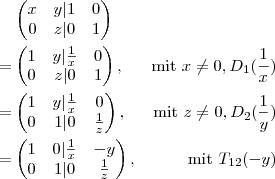Achtung: Dies ist eine historische Web-Site.
Aktuell ist https://rainer.gerhards.net/ (engl) bzw
https://www.rainer-gerhards.de/ (deutsch).
Alle dynamischen Funktionen, Formulare etc auf dieser Seite sind abgeschaltet.
Datenschutzerklärung
Impressum
 soll die Matrix A ermittelt werden, als Beispiel gelte die Aufgabe
soll die Matrix A ermittelt werden, als Beispiel gelte die Aufgabe


 und
und  :
:

 invertierbar ist. In unserem Beispiel ist sie das aber. Ich invertiere nun zunächst diese Matrix:
invertierbar ist. In unserem Beispiel ist sie das aber. Ich invertiere nun zunächst diese Matrix:
